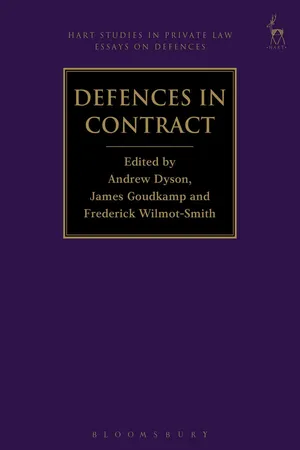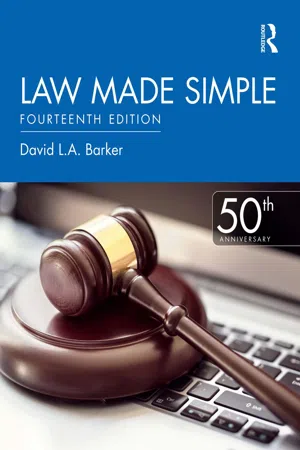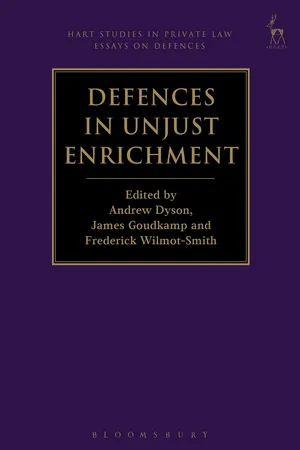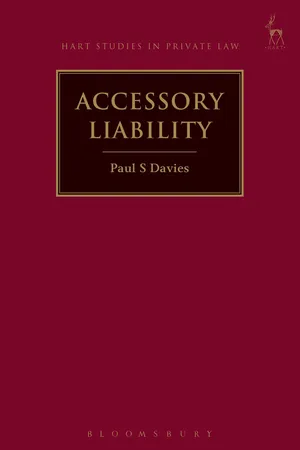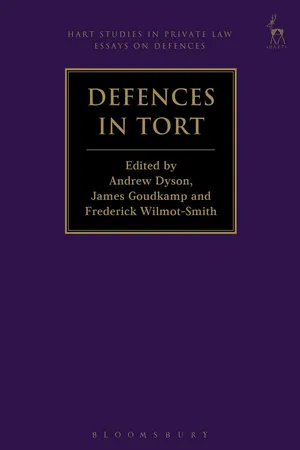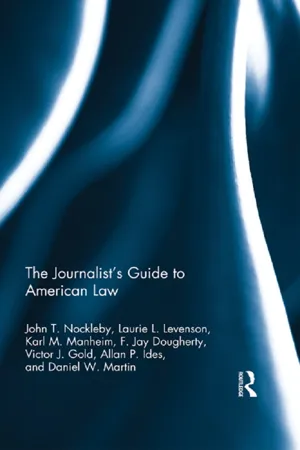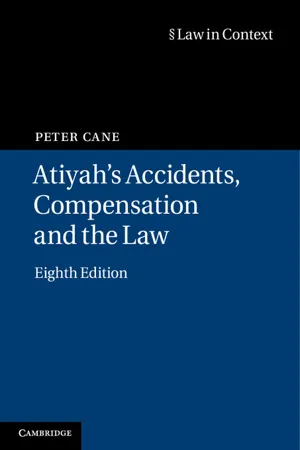Law
Defences in Tort
Defences in tort refer to legal arguments or justifications that can be used by defendants to avoid liability for a tortious act. These defences can include contributory negligence, consent, necessity, and statutory authority, among others. They provide a means for defendants to challenge the plaintiff's claim and potentially avoid legal responsibility for the harm caused.
Written by Perlego with AI-assistance
Related key terms
1 of 5
11 Key excerpts on "Defences in Tort"
- eBook - PDF
- Matthew Dyson(Author)
- 2014(Publication Date)
- Cambridge University Press(Publisher)
The term ‘defence’ is often deployed to refer to any argument made by the defendant that, if accepted by the court, will result in the defendant being released from liability. In this sense of the word, defences include contentions by the defendant that an element of the tort or crime that he is alleged to have committed is absent. Used in this way, it is a defence for a defendant who is charged with rape to assert that the complainant consented to sexual intercourse, and it is a defence for a defendant who is sued in the action in negligence to maintain that he took reasonable care. The word ‘defence’ is also used in a narrower sense to refer only to rules that, if applicable, result in the defendant being released from liability for an offence or a tort even though all of the elements of the relevant offence or tort are present. When the word ‘defence’ is given this meaning, only those rules that prevent liability from arising that are external to the definitions of torts and crimes count as defences. Such rules include the doctrine of self-defence, limitation bars and immunities. In this chapter, the word ‘defence’ will be used in the stricter sense. Denials by the defendant that all of the elements of offences or torts are present will not, therefore, be treated as defences. Note, also, that the definition of the word ‘defence’ that has just been adopted excludes rules that merely affect the way in which the court responds to liability. Such rules are sometimes referred to as defences. An example is the 6 In the criminal law, a defendant can benefit from the defence of self-defence even if his mistake is unreasonable: Criminal Justice and Immigration Act 2008 (UK), s. 76(4)(b)(ii); Shaw v. R [2001] UKPC 26, [2001] 1 WLR 1519. In tort law, unreasonable mistakes are not within the defence: Ashley v. Chief Constable of Sussex Police [2008] UKHL 25, [2008] 1 AC 962. See also the discussion in Duff’s chapter in this volume, esp. - eBook - PDF
- Andrew Dyson, James Goudkamp, Frederick Wilmot-Smith, Andrew Dyson, James Goudkamp, Frederick Wilmot-Smith(Authors)
- 2017(Publication Date)
- Hart Publishing(Publisher)
7 Whether contract law recognises defences depends on how the concept of a defence is understood. 8 In this section we argue that there are several examples of contract law doctrines that meet each of three popular definitions. 9 The upshot is that the failure of contract law scholars to employ the concept of defences cannot be explained on the ground that there are no defences in the law of contract. A. Rules that are External to the Cause of Action In his chapter in Defences in Tort , Graham Virgo wrote that ‘[a] denial negates an element of the [claim], whereas a defence is a rule that relieves the defendant Thinking in Terms of Contract Defences 3 10 G Virgo, ‘Justifying Necessity as a Defence in Tort Law’ in A Dyson, J Goudkamp and F Wilmot-Smith (eds), Defences in Tort (Oxford, Hart Publishing, 2015) 139. 11 Barker, Chapter 2 of this volume, p 35. For an assessment of this conception of a defence, see L Duarte d’Almeida, ‘Defining “Defences”’ in A Dyson, J Goudkamp and F Wilmot-Smith, Defences in Tort (Oxford, Hart Publishing, 2015). Daniel Markovits uses this definition of the term defence in his contribution to this volume. He writes that ‘a party that seeks to avoid enforcement of boilerplate does not offer a defence against contractual obligation so much as directly deny that the boilerplate belongs in the contract to begin with’: Markovits, Chapter 3 of this volume, p 46 (Markovits). 12 On some accounts, rules that only partially relieve the defendant of liability are not defences. 13 Barker, Chapter 2 of this volume, p 35. 14 Limitation Act 1980 (UK) ss 5–7. Compare Duarte d’Almeida (n 11) 51–52 (arguing that limitation is a procedural bar, not a defence). 15 A Burrows, ‘Some Recurring Issues in relation to Limitation of Actions’ in A Dyson, J Goudkamp and F Wilmot-Smith (eds), Defences in Tort (Oxford, Hart Publishing, 2015) 310. - Jean-Sébastien Borghetti, Simon Whittaker, Jean-Sébastien Borghetti, Simon Whittaker(Authors)
- 2019(Publication Date)
- Hart Publishing(Publisher)
fin de non-recevoir concerns the absence or loss of the right to sue due, for instance, to prescription. Call definition (3) the ‘merit-based definition’ of defences.Definition (4) refers to rules which restrict the scope of the remedy or range of remedies available where liability is established, but do not defeat liability entirely. For instance, contributory negligence is routinely referred to as a defence in English law, but is not under definitions (1)–(3).Definition (5) refers simply to who has the burden of proof in relation to a factual issue. If the defendant must prove the absence of fault under a particular rule, then the absence of fault is a ‘defence’ according to this definition. Typically, the classification of a fact as a defence in the sense of definition (2) entails that the burden of proof is on the defendant in respect of that fact. Thus there is a significant overlap between definitions (2) and (5). Call this the ‘proof-based definition’ of defences.This chapter will primarily be concerned with defences in the externalist definition (2) and proof-based definition (5) senses. Why? First, the externalist and proof-based conceptions have some claim to being the central or, at least, most widely employed notions of defence.4 Second, if we use defence to mean definition (1), then we are essentially referring to the entirety of tort and contract law. If definition (1) includes a ‘fact’ such as the absence of breach, or the absence of damage, then any absent element of any cause of action can be described as a defence. Similarly, if definition (4) is employed, then any remedy-restricting fact, such as a break in the chain of causation, will be counted as a ‘defence’. It is not possible to compare the entirety of English and French tort and contract laws in this chapter: a more restrictive definition is needed. This is subject to the caveat that, if a fact is counted as an externalist defence in English law, but is a denial in French law (or vice versa), then it merits inclusion here. Furthermore, the focus will be upon facts which satisfy both the merit-based and proof-based definitions. This is, again, partly for reasons of space, but also for the reason that such facts are likely to be within the core of what is counted as a defence.5- Martin Jarrett(Author)
- 2019(Publication Date)
- Cambridge University Press(Publisher)
The conduct regarding the timing of a claim’s submission 27 Wigmore, ‘Tripartite Division of Torts’, 207–208. 28 Goudkamp, Tort Law Defences, 4 and 47. 29 Ibid., 4. 30 Restatement (First) of Torts, § 653(1)(a)(i). 31 While the tort of malicious prosecution is contained in Division Seven, the applicable defences are contained in Division Twelve. 32 See sections 5.3.1 and 5.3.2 below for a discussion of the distinction between defences and claim admissibility rules. 33 For a similar view, see Duarte d’Almeida, ‘Defining “Defences” ’, 51–52. Most jurists, however, hold that claim limitation periods are defences; see Dyson and others, ‘Thinking in Terms of Contract Defences’, 3. 34 See section 1.1 above. A Definition of Defence 22 2 cannot be described as one of these facts as it is a circumstance relating to the claim itself. 1.6 Legal Function of Defences: Elimination or Reduction of Liability Defences operate to either eliminate or reduce the respondent’s liability. While defences that eliminate liability are complete defences, defences that reduce liability are partial defences. Partial defences enjoy wide recognition in domestic criminal law, 35 but are more controversial in domestic private law 36 and international law. 37 In international investment law, however, partial defences have been impli- citly, albeit unconsciously, recognised as ‘limitations on compensation’. 38 Yukos v. Russia offers an example. There, after having determined that the investors made a faultworthy contribution to their losses 39 in the form of investment reprisal, 40 the arbitral tribunal concluded that: the Claimants contributed to the extent of 25 percent to the prejudice they suffered at the hands of the [respondent]. As a consequence, the amount of damages to be paid by Respondent to Claimants will be reduced by 25 percent. 41 The reference to reducing damages is unfortunate because it suggests that investment reprisal acts as a reduction on remedies, as opposed to liability.- eBook - ePub
- David L.A. Barker, David L. A. Barker(Authors)
- 2020(Publication Date)
- Routledge(Publisher)
Chapter 8The law of torts
Key points
- the nature of a tort
- general Defences in Tort
- capacity of parties
- specific torts: trespass
- specific torts: nuisance
- specific torts: negligence
- specific torts: defamation
The word ‘tort’ derives from the Latin tortus , meaning crooked or twisted, and the Norman-French tort , meaning wrong. In English law we use the word tort to denote certain civil wrongs as distinct from criminal wrongs.The early Anglo-Saxons did not distinguish between civil wrongs and criminal wrongs. In the Middle Ages, however, the idea sprang up that certain wrongs of an antisocial kind, e.g. treason, murder, theft, arson and the like, were offences against the King or the State. The King’s peace, as it was called, extended to every corner of the land, and all crimes were at the same time breaches of the peace. Certain other wrongs, done by one person to another, were disregarded by the King and the State. These were left to be enforced by the person claiming to be injured or wronged. The injured claimant decided whether to take action or not. The claim, if any, was for damages, i.e. money compensation or reparation for the injury inflicted by the defendant.Whether or not a claimant had a right of action against another for an alleged wrong depended on the existence of a writ wherewith to begin the action. The rights available depended in practice on the writs available. The forms of action, as these were called, enshrined the rights. If there was no writ there was no remedy available in the courts of law.The most important all-purpose writ that covered the common civil wrongs in medieval society was trespass . This was available for all direct injuries to the person, goods or lands. Thus a personal injury to another, e.g. assault and battery, damage to personal goods, to gates, hedges, lands or mere entry on lands or cattle trespass, fell within the ambit of trespass.The writ of trespass was aptly called ‘the fertile mother of actions’. After the Statute of Westminster II, 1285, there grew up offshoots of trespass, named trespass on the case . Whereas the writ of trespass was available for all direct and forcible injuries, the writs of trespass on the case were used for all injuries that were indirect - eBook - ePub
- Andrew Dyson, James Goudkamp, Frederick Wilmot-Smith, Andrew Dyson, James Goudkamp, Frederick Wilmot-Smith(Authors)
- 2016(Publication Date)
- Hart Publishing(Publisher)
3 Defence, Denial or Cause of Action? ‘Enrichment Owed’ and the Absence of a Legal Ground HELEN SCOTT 1. DEFENCES AND DENIALST HE DISTINCTION BETWEEN defences and denials proposed by James Goudkamp in his recent book Tort Law Defences is an extremely useful analytical tool in the hands of tort lawyers.1 According to his typology, the term ‘defence’ refers to a rule that, when enlivened, results in a verdict for the defendant even though all the ingredients of the tort in which the claimant sues are present.2 By contrast, a denial is a plea by the defendant that one of the elements of the tort in which the claimant sues is absent; it does not introduce into the proceedings any issue that the claimant will not already have put in contention.3 Thus, the definition of tort defences is for Goudkamp a substantive rather than a procedural question, in the sense that it does not turn on the distribution of the burden of proof between the parties.4 Admittedly, there remains a close correspondence between defences and the burden of proof: it is almost always for the defendant to plead and prove a defence.5 Nevertheless, according to his typology, the distinction between actions and defences, and more specifically denials and defences, turns on substantive arguments about the definition of torts.The distinction between denials and defences has now been extended by James Goudkamp and Charles Mitchell to the law of unjust enrichment.6 As in the context of tort, here the term ‘denial’ refers to any argument by the defendant that liability should not be imposed because one or more of the elements of the claimant’s action is missing,7 whereas the term ‘defence’ refers specifically to a rule enabling the defendant to be wholly or partly relieved of liability which is independent of or extrinsic to the claimant’s action.8 Here, too, defences are defined independently of the distribution of the burden of pleading and proof.9 Under the heading ‘Rationalising the Distinction between Actions and Defences’, Goudkamp and Mitchell discuss a number of possible justifications for the existence of defences in the law of unjust enrichment.10 These are all more or less instrumental arguments and all five are general in nature, appropriate not only to the unjust enrichment context but also to tort.11 Goudkamp and Mitchell claim, further, that: ‘If the distinction between actions and defences is justifiable, the rationale or rationales that support it may bear upon how rules that govern liability should be classified.’12 - eBook - PDF
- Paul S Davies(Author)
- 2015(Publication Date)
- Hart Publishing(Publisher)
For example, if defamatory remarks cause no damage to the claimant, then the objective element of damage can be denied by all defendants: Goudkamp, Tort Law Defences , above n 6 at 143. 23 Indeed, it is unclear whether any wrong is committed if the claimant consents: see eg WVH Rogers, Winfield and Jolowicz on Tort , 18th edn (London, Sweet & Maxwell, 2010) 108. 24 Similarly, if the claimant’s loss arises as a result of his or her own illegal conduct, then his or her claim may not be allowed to succeed against any defendant: see eg Gray v Thames Trains Ltd [2009] UKHL 33, [2009] AC 1339. 226 Defences II. Justification The defence of justification has been best recognised in the contractual context. 25 Participation in a breach of contract may be easier to justify than participation in other private law wrongs: contractual rights may often appear to be of ‘lesser’ importance than the rights of a beneficiary in a fiduciary relationship, or rights protected by the law of tort, such as freedom and bodily integrity. 26 But this does not mean that an entirely different approach should be taken as regards justifica-tion in each area of the law: fundamentally, it must be established that the defend-ant was acting reasonably, and only to the extent necessary, to protect something that trumps the claimant’s rights. Various factors will be important in this balanc-ing exercise; the nature of the claimant’s rights might affect the weight to be given to particular factors, but different rights do not necessitate different tests of justi-fication. 27 However, the contours of the defence of justification have not been clearly defined, even in the contractual sphere. Carty has observed that ‘clarity – obvi-ously important in the commercial world – demands that liability be imposed on grounds that are certain and that the defence of justification should be residual’. - eBook - PDF
- Andrew Dyson, James Goudkamp, Frederick Wilmot-Smith, Andrew Dyson, James Goudkamp, Frederick Wilmot-Smith(Authors)
- 2015(Publication Date)
- Hart Publishing(Publisher)
But it is clear that, despite legal history, privacy claims sit slightly uncertainly on the traditional boundaries of tort, equity, and even, sometimes, contract law, so that the discussion is not totally out of place. Although defences become relevant only once a wrong has been made out, defences are of course an intrinsic and critical part of any cause of action, in a broad sense. 2 It is, in fact, difficult to think of a legal obligation or wrong to which there are no defences whatsoever. This suggests that it is only by acknowledging the existence of defences that the cause of action becomes settled. Absolute liability is usually unacceptable—simply because it is too absolute a consequence for the vagaries of human conduct. Some foundational issues have turned out to be the major focus of this chapter. It begins with a discussion of why, despite history, modern privacy law arguably fits best in the province of tort law. Then, because the availability of Defences in Tort law tends to depend on whether the facts give rise to an intentional tort, a tort of negli-gence, or a tort of strict liability, further foundational analysis and classification is required. 3 The chapter therefore analyses the fault element in claims for breach of 1 Wainwright v Home Offic e [2003] UKHL 53; [2004] 2 AC 406. The High Court of Australia in Australian Broadcasting Corp v Lenah Game Meats Pty Ltd [2001] HCA 63; (2001) 208 CLR 199 held that a previous High Court decision Victorian Park Racing and Recreation Grounds Co Ltd v Taylor (1937) 58 CLR 479 (HCA), in which it was said, for example, at 517, that English law does not recog-nise any general right to privacy, did not stand in the way of the development of such a cause of action. Despite the High Court’s encouragement, there is as yet no appellate authority in Australia recognising such a tort. See further the Australian Law Reform Commission, Serious Invasions of Privacy in the Digital Era (Law Com Rep No 123, 2014). - eBook - ePub
- John Nockleby, John T. Nockleby, John Nockleby, John T. Nockleby(Authors)
- 2013(Publication Date)
- Routledge(Publisher)
Many other business torts and statutory causes of action are available to challenge unfair or unwarranted commercial advantages. Claims such as interference with others’ contracts, misappropriation, breach of fiduciary duty, and civil conspiracy are sometimes available. Additional torts that may be available to businesses and others include claims against insurance companies for failure to pay legitimate claims; misuse of legal process; and unfair competition. Recent years have also seen a proliferation of statutory torts, including racketeering (or civil RICO), antitrust claims, securities fraud, and trademark and other intellectual property disputes. Many states have enacted statutes that cover these and other wrongs.Defenses to Intentional TortsEven if the plaintiff establishes a prima facie case of intentional tort, the defendant may still avoid liability if it can establish an affirmative defense, or show that it was engaging in privileged conduct that resulted in interference with plaintiff’s interests. In a trial setting, the defendant ordinarily has the burden of establishing the elements of an affirmative defense. When a court recognizes a privilege, it essentially says to the plaintiff, “even though your interests have been interfered with by defendant, the defendant is permitted to do so.”The process of creation and destruction of privileges provide an important insight into the tort system. When judges (or legislatures) recognize a privilege, they are engaging in an important type of balancing of social interests, often evaluating whether it is better for society to recognize the privilege or not. In addition, once a privilege is created, judges must then decide its scope: should it be broadly construed or narrowly defined?The legal system recognizes many defenses and privileges to interfere with another’s interests. For example, courts will recognize defenses such as consent; self-defense and defense of others; defense of property and privilege to “recapture” chattels; official privilege (including arrest); privilege of necessity; and privilege to compete. Some privileges are no longer recognized, such as the ability of husbands to “discipline” (beat) their wives. Some privileges, such as the privilege to “discipline” children are gradually being narrowed by the courts in view of much greater attention to child abuse. - eBook - ePub
- Chris Monaghan(Author)
- 2015(Publication Date)
- Taylor & Francis(Publisher)
The difference between tort law and contract law is that in tort legal obligations arise irrespective of whether there is a contract between the claimant and defendant. This means that in contract law the parties will voluntarily contract and accept their obligations, whereas in tort the law imposes obligations that will be owed to others regardless of whether they have consented to them. That is not to say that the parties to a contract will have complete freedom to determine the extent of their obligations, as the law has restricted the freedom of contract by introducing rules on the validity of certain terms and by introducing mandatory obligations for particular types of contracts. The law of tort has developed to establish that a duty of care will be owed in different circumstances and seeks to regulate our conduct by imposing an obligation to avoid causing others loss. You will see how the different torts arise and how a business will need to understand first its legal obligations and thus try to avoid liability, and second the protection that is afforded to it by tort law.In this chapter we will consider how the material covered will relate to a fictional business, Temple, Strand & Holborn Ltd (TSH Ltd). TSH Ltd specialises in fitting out shops.Figure 5.1 Key torts covered in this chapterRemedies
Unlike contract law the aim of damages in tort law is to put the claimant back in the position she was in prior to the tort occurring. Damages are intended to be compensatory in nature. There are different types of damages available, depending on the circumstances of the claim. In addition to damages a claimant may seek the court to award an equitable remedy such as an injunction. Injunctions are awarded at the court’s discretion and are commonly sought in order to prevent a party from acting in a way that would amount to a civil wrong. For example, we will see below that the defendant could be liable where he passes off his goods as being associated with the claimants. An injunction could be awarded to prevent the defendant from selling these goods.Temporary pre-trial injunctions
A party can apply for an interlocutory injunction that is a temporary restraint to prevent another party from acting in a certain way until the trial. The test for whether such an injunction should be awarded by the court was established in American Cyanamid Co v Ethicon Ltd (No 1) - eBook - PDF
- Peter Cane(Author)
- 2013(Publication Date)
- Cambridge University Press(Publisher)
74 The defence is of theoretical interest because it raises in acute form the question of the proper role of tort law: is it to compensate the injured, or 70 Phillips v. William Whitely [1938] 1 All ER 566. 71 Withers v. Perry Chain Co. [1961] 1 WLR 1314. 72 E.g. Revill v. Newbery [1996] QB 567. 73 Pitts v. Hunt [1991] 1 QB 24. 74 Road Traffic Act 1988, s. 149(3). 63 Conduct of the claimant to give effect to judgments about fault by compensating injured persons in appropriate circumstances, or to deter culpable conduct? The situation is made more complicated by worries about the extent to which the courts would lower their prestige and credibility if they were to ‘help’ criminals by awarding them damages. A number of basic problems have troubled the courts. The first concerns the extent to which the civil law ought to be used as an adjunct to or reinforcement for the criminal law. The argument that it should be so used is a two-edged sword where both the claimant and the defendant were acting illegally at the time of the injuries. To deny compensation might deter the claimant from criminal activity in the future, but relieving the defendant of liability for tortious conduct could hardly have a deterrent effect. A second point is that much modern ‘criminal’ legislation is in fact only regulatory; it is very often designed to co-ordinate human behaviour for the sake of efficiency or to set safety standards to protect people from their own carelessness or stupidity. Little, if any, stigma will attend breach by injured persons of many such laws; and so, while deterrence of breach by means, for example, of a fine may be desirable, the unpredictable and usually much more serious sanction of the denial of a civil remedy may seem an unnecessary and unduly harsh sanction.
Index pages curate the most relevant extracts from our library of academic textbooks. They’ve been created using an in-house natural language model (NLM), each adding context and meaning to key research topics.

